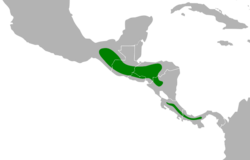Biology:Cabanis's seedeater
| Cabanis's seedeater | |
|---|---|
| Scientific classification Error creating thumbnail: Unable to save thumbnail to destination
| |
| Domain: | Eukaryota |
| Kingdom: | Animalia |
| Phylum: | Chordata |
| Class: | Aves |
| Order: | Passeriformes |
| Family: | Cardinalidae |
| Genus: | Amaurospiza |
| Species: | A. concolor
|
| Binomial name | |
| Amaurospiza concolor Cabanis, 1861
| |

| |
The Cabanis's seedeater (Amaurospiza concolor) is a species of bird in the cardinal family Cardinalidae that the International Ornithological Committee (IOC) accepted as a species in 2015. (But see the taxonomy section below.) It is found southern Mexico and Central America.[1]
Taxonomy and systematics
In 2015 the IOC split the subspecies Amaurospiza concolor aequatorialis from the blue seedeater (Amaurospiza concolor sensu lato) as the Ecuadorean seedeater (Amaurospiza aequatorialis) and renamed A. concolor Cabanis's seedeater.[1] The decision was based on a molecular phylogenetic study published in 2014.[1][2] However, the South American Classification Committee of the American Ornithological Society (AOS) had previously rejected the split, and as of May 2021 the AOS North American Committee has not considered it and the Clements taxonomy has not adopted it.[3][4][5] Confusingly, BirdLife International uses the scientific name A. moesta for blue seedeater, but the IOC, AOS, and Clements assign that binomial to blackish-blue seedeater. The BirdLife account encompasses what are now Cabanis's, Ecuadorian, and blackish-blue seedeaters.[6][7][3][5]
Cabanis's seedeater as defined by the IOC has two subspecies, the nominate Amaurospiza concolor concolor and A. c. relicta.[7]
Description
Cabanis's seedeater is 11.5 to 14 cm (4.5 to 5.5 in) long and weighs 12 to 15 g (0.42 to 0.53 oz). The nominate male is entirely slate blue. The female's upperparts are cinnamon and the underparts tawny. The male A. c. relicta is more slaty (less blue) than the nominate and has black lores; the female is a paler cinnamon.[8]
Distribution and habitat
The nominate Cabanis's seedeater is found from Chiapas in southern Mexico through Central America to western and central Panama. A. c. relicta is found in six southwestern Mexico states, Jalisco, Colima, Morelos, Puebla, Guerrero and Oaxaca. The species inhabits openings in and edges of humid montane and secondary forest. It most often is found at sites with bamboo. In northern Central America it ranges in elevation from 600 to 2,500 m (2,000 to 8,200 ft) but in Costa Rica inhabits the narrower range of 1,700 to 2,200 m (5,600 to 7,200 ft).[8]
Behavior
Feeding
Cabanis's seedeater's diet includes insects, seeds, and bamboo shoots.[8]
Breeding
The only known Cabanis's seedeater nest was found in Mexico. It was a cup of coarse grass lined with finer grass placed in the fork of a slender branch. It contained two seedeater eggs and one of the brood parasite bronzed cowbird (Molothrus aeneus).[8]
Vocalization
Cabanis's seedeater's songs and calls have been transcribed in several ways.[8] A song from Chiapas, Mexico, is [1]. One from Panama is [2]. A call from Puebla, Mexico, is [3] and one from Panama is [4].
Status
The IUCN has not assessed Cabanis's seedeater.
References
- ↑ 1.0 1.1 1.2 Gill, F.; Donsker, D. (April 2015). "IOC World Bird List (v 5.2)". https://www.worldbirdnames.org/.
- ↑ Bryson, R.W. Jr; Chaves, J.; Smith, B.T.; Miller, M.J.; Winker, K.; Pérez-Emán, J.L.; Klicka, K. (2014). "Diversification across the New World within the 'blue' cardinalids (Aves: Cardinalidae)". Journal of Biogeography 41: 587–599 [590]. doi:10.1111/jbi.12218.
- ↑ 3.0 3.1 Remsen, J. V., Jr., J. I. Areta, E. Bonaccorso, S. Claramunt, A. Jaramillo, D. F. Lane, J. F. Pacheco, M. B. Robbins, F. G. Stiles, and K. J. Zimmer. Version 19 January 2021. A classification of the bird species of South America. American Ornithological Society. https://www.museum.lsu.edu/~Remsen/SACCBaseline.htm retrieved 19 January 2021
- ↑ "Check-list of North and Middle American Birds". American Ornithological Society. 30 June 2020. http://checklist.aou.org/taxa.
- ↑ 5.0 5.1 Clements, J. F., T. S. Schulenberg, M. J. Iliff, S. M. Billerman, T. A. Fredericks, B. L. Sullivan, and C. L. Wood. 2019. The eBird/Clements Checklist of Birds of the World: v2019. Downloaded from https://www.birds.cornell.edu/clementschecklist/download/ Retrieved 15 August 2019
- ↑ BirdLife International (2018). "Amaurospiza moesta". IUCN Red List of Threatened Species 2018: e.T105965570A132047632. doi:10.2305/IUCN.UK.2018-2.RLTS.T105965570A132047632.en. https://www.iucnredlist.org/species/105965570/132047632. Retrieved 16 November 2021.
- ↑ 7.0 7.1 Gill, F.; Donsker, D.; Rasmussen, P. (January 2021). "IOC World Bird List (v 11.1)". https://www.worldbirdnames.org/.
- ↑ 8.0 8.1 8.2 8.3 8.4 Ramos-Ordoñez, M. F., C. I. Rodríguez-Flores, C. A. Soberanes-González, M. d. C. Arizmendi, A. Jaramillo, and T. S. Schulenberg (2020). Blue Seedeater (Amaurospiza concolor), version 1.0. In Birds of the World (T. S. Schulenberg, Editor). Cornell Lab of Ornithology, Ithaca, NY, USA. https://doi.org/10.2173/bow.blusee1.01 retrieved 16 May 2021
External links
Wikidata ☰ Q1591459 entry

